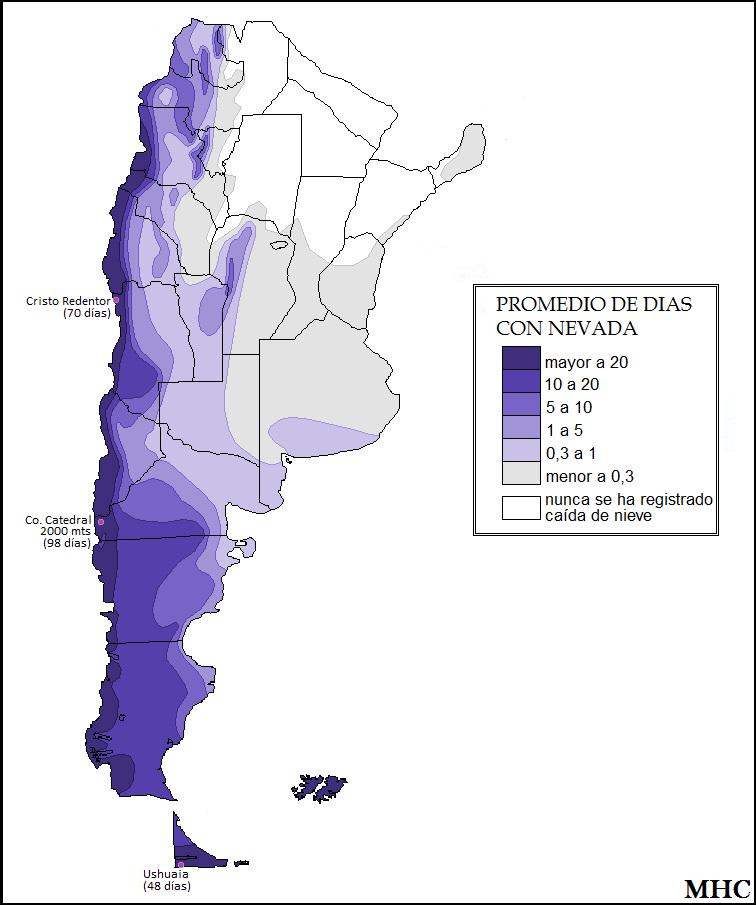Average Number of Snow Days per Year in Argentina Map


David Chen
Data Visualization Specialist
David Chen is an expert in transforming complex geographic datasets into compelling visual narratives. He combines his background in computer science ...
Geographic Analysis
What This Map Shows
The 'Average Number of Snow Days per Year in Argentina Map' provides a detailed visualization of how many days each region of Argentina experiences snowfall annually. Snow days can significantly affect local climates, economies, and even lifestyles. This map highlights the stark contrasts in snowfall across the country, revealing that snow is not a uniform phenomenon in Argentina. While some areas may see frequent snowfalls, others remain largely untouched by winter's chill.
Deep Dive into Snow Days in Argentina
Snowfall in Argentina is a complex subject, primarily influenced by the country's diverse geography. From the arid deserts of the northwest to the frigid climates of the southern Patagonian region, Argentina showcases a broad spectrum of weather patterns. Interestingly, snowfall is most common in the Andean regions and parts of Patagonia, where elevation plays a critical role in temperature and precipitation.
In Argentina, the average number of snow days ranges significantly. For instance, provinces like Neuquén and Río Negro can experience up to 20-30 snow days per year, particularly in the mountainous areas. In contrast, regions such as Buenos Aires, located in the east, see little to no snowfall due to their milder climate. Here, the average annual temperature often hovers around 15°C (59°F), making snow a rare event.
The climatic conditions necessary for snowfall include a combination of low temperatures and moisture. The Andes mountain range acts as a barrier, capturing moist air from the Pacific Ocean. This orographic lift causes the air to cool and condense, leading to precipitation that falls as snow at higher altitudes. Notably, areas like Bariloche are renowned for their skiing resorts, thriving due to the consistent snowfall that attracts winter sports enthusiasts.
However, snow days are not just a meteorological curiosity; they have real-world implications. For example, in regions that rely heavily on winter tourism, such as the ski resorts in Mendoza and Patagonia, the number of snow days can directly influence the local economy. A year with fewer snow days can result in lower tourist numbers, impacting local businesses and jobs.
Regional Analysis
Argentina's climatic diversity leads to varied snowfall patterns across its different regions. In the northwestern provinces, such as Jujuy and Salta, snowfall is minimal, usually limited to the highest peaks. Here, snow days rarely exceed five per year, making snow a novelty rather than a norm.
In stark contrast, the southern regions of Argentina, particularly Tierra del Fuego and parts of Santa Cruz, experience some of the highest averages of snow days in the country. Reports indicate that areas like Ushuaia, known as the southernmost city in the world, can see upwards of 30 snowfall days annually. This dramatic variation illustrates how geography shapes not only climate but also the lifestyle and economic activities of the inhabitants.
Interestingly, the mid-region provinces like Mendoza and San Juan experience a more moderate climate. They may receive snow, but typically only in the higher elevations of the Andes. The snow here serves as an essential water source for agriculture during the dry summer months, showcasing the interplay between snow and water resources in these regions.
Significance and Impact
Understanding the average number of snow days across Argentina is more than just an academic exercise; it has significant implications for agriculture, tourism, and climate change. For instance, as global temperatures continue to rise, many regions that previously experienced regular snowfall may see a decrease in snow days. This shift could have dire consequences for water supplies, especially in areas reliant on snowmelt for irrigation.
Additionally, the tourism sector could face challenges as snowfall patterns change. Ski resorts may need to adapt to fluctuating snow conditions, potentially investing in artificial snow-making technologies to maintain their operations. Have you noticed the increasing importance of climate resilience in tourism planning?
In conclusion, the average number of snow days per year in Argentina is a fascinating topic that reflects the intricate relationship between geography and climate. As we move forward, monitoring these changes and adapting to our environment will be crucial for the regions most affected by snow variability. Whether you're a geography enthusiast or simply curious about climate trends, the snowfall patterns in Argentina offer a compelling insight into how our world is connected and continuously changing.
Visualization Details
- Published
- October 15, 2025
- Views
- 36
Comments
Loading comments...